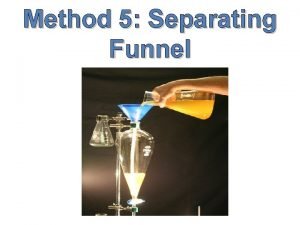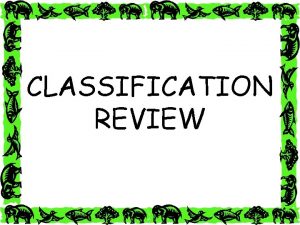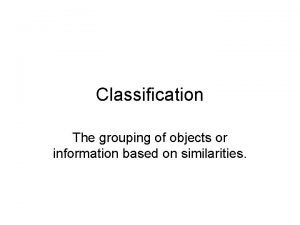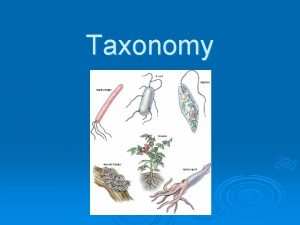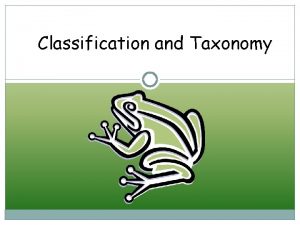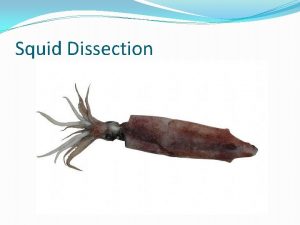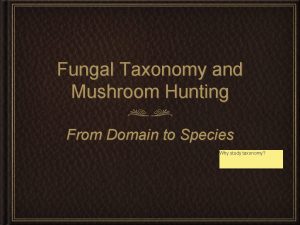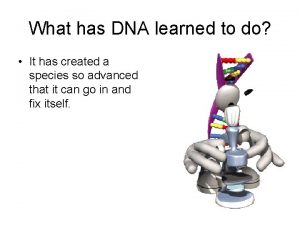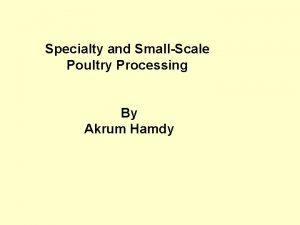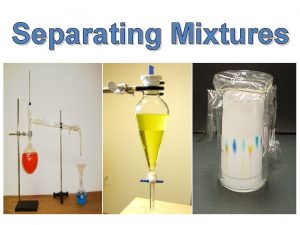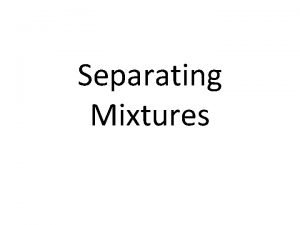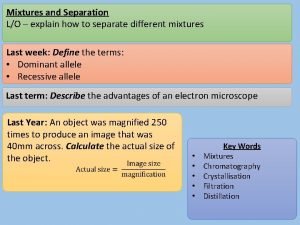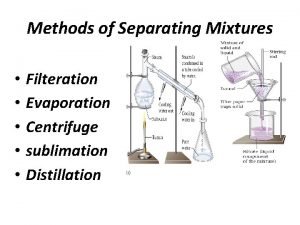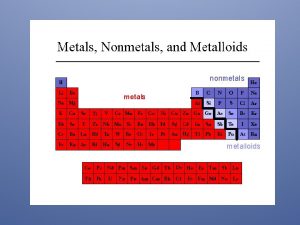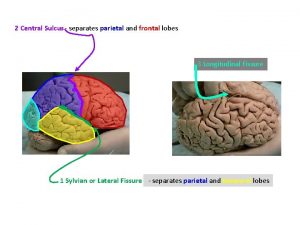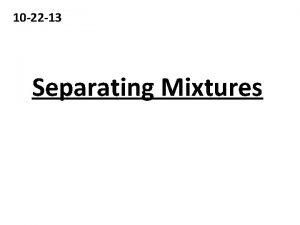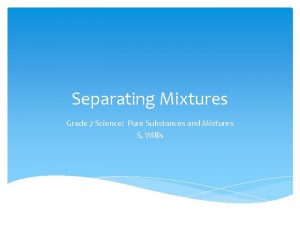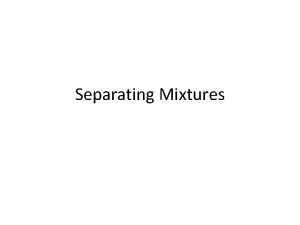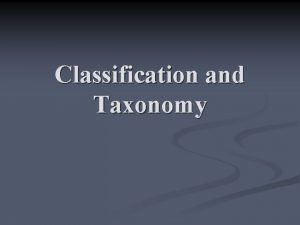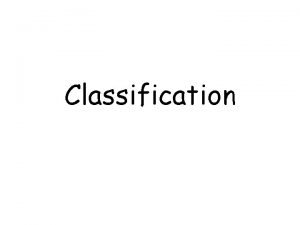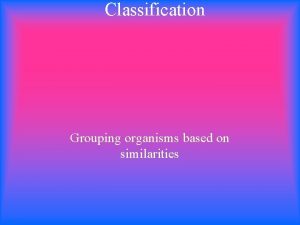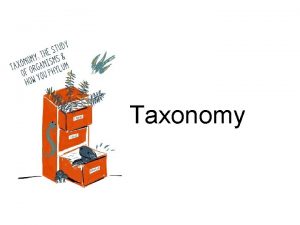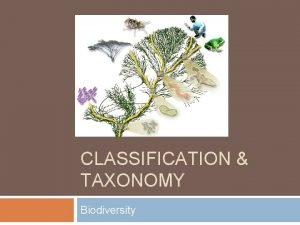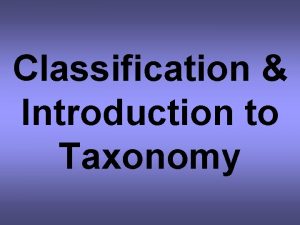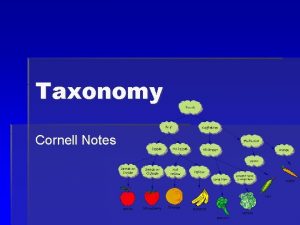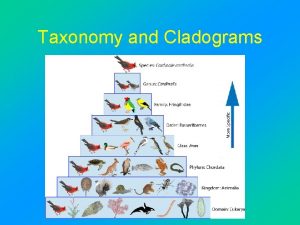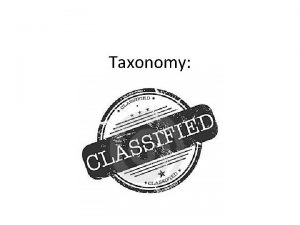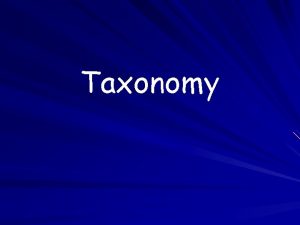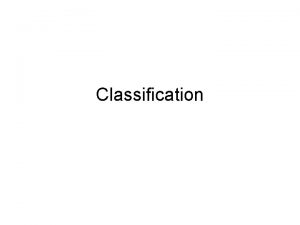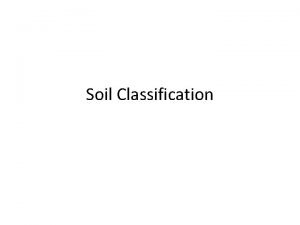Ch 17 Classification Taxonomy Classification Organizing Grouping Separating




































- Slides: 36

Ch. 17 Classification & Taxonomy

Classification: • • • Organizing Grouping Separating Categorizing Sorting

Why Classify? • • • Increases understanding Eases identification More efficient Less clutter Saves time Makes “life” easier

Biodiversity • There are ______ different types (species) of organisms on Earth!


Taxonomy: Science of naming and classifying organisms. Early Taxonomy • Cave Folks • Aristotle: 2 K years ago. Greek philosopher and naturalist that classified organisms according to structural similarities and locomotion.

• Romans/Greeks classified organisms into broad groups • Until the mid-1700’s, organisms were given long descriptive names in Latin – “polynomials” • Carolus (Carl) Linnaeus: Swedish botanist. 1750’s. System based on organism’s form or structure. Binomial Nomenclature.

Binomial Nomenclature: Each organism given two Latin names…. . • • Genus: (general name) “Washington” Contains similar species Species: (specific name) “George”

Scientific Name: Genus + species name. • Always either underlined or italicized! • Give biologists a common way of communicating regardless of their native language. Homo sapiens or Homo sapiens

Linnaeus also devised a system of inclusive groups for the complete classification of an organism.

8 Classification Groups Domain Kingdom Phylum Class Order Family Genus Species




Domains: Contain Kingdoms. Only 3. Archaea, Bacteria (both prokaryotes), and Eukarya

How Biologists Classify Organisms • Biological Species: Group of natural populations that are capable of interbreeding and producing fertile offspring. • - Only useful for sexually reproducing organisms. Useless for asexually reproducing species.

Mule: offspring of male donkey and female horse

Coydog

Liger

Tiger Musky


• Reproductive Isolation: Occurs when a barriers separates two or more groups of organisms and prevents them from interbreeding. • When reproductive barriers between two species are not complete, the two species are usually closely related.

• In Kingdom Animalia, strong barriers to hybridization usually exist. • In practice, the best way to recognize species is by studying the organism’s features/structures

1. 5 million species named and described to date. Phylogeny: Evolutionary history of a species Similar characteristics may indicate that two species share a common ancestor. Or, may also be evidence of convergent evolution.

Convergent Evolution: Two or more different species evolve similar features (analogous structures) because they live in or occupy similar environments/niches.




Cladistics: • A method of classification in which the relationships between organisms are based on selected shared characteristics.

• Can be used to hypothesize the sequence in which different groups of organisms evolved. • Reconstructs evolutionary history. • Ancestral character: characteristic that evolved in a common ancestor of both groups.

• Derived character: characteristic that evolved in one group but not the other. • Cladistics based on the principle that shared derived characters/traits provides evidence that two groups are relatively closely related.

• Cladogram: branching diagram that shows the evolutionary relationships among groups of organisms. Objective.



• Evolutionary Systematics: Phylogenetic tree. Demonstrates varying degrees of importance to characters/traits. Subjective. • Both cladograms and phylogenetic trees represent a hypothesis of evolutionary history.

 Dissolve
Dissolve The process of grouping things based on their similarities
The process of grouping things based on their similarities This is the study of grouping and naming organisms
This is the study of grouping and naming organisms Kendall and marzano
Kendall and marzano Grouping of objects or information based on similarities
Grouping of objects or information based on similarities How do cladograms and fanlike diagrams differ
How do cladograms and fanlike diagrams differ How to write a scientific name
How to write a scientific name Examples of dichotomous key
Examples of dichotomous key Horse class taxonomy
Horse class taxonomy Whats a dichotomous key
Whats a dichotomous key Kingdom of a squid
Kingdom of a squid Mushroom domain
Mushroom domain Separating dna
Separating dna Separating eggs techniquies
Separating eggs techniquies Distillation grade 7
Distillation grade 7 Filtration used to separate
Filtration used to separate Evaporation
Evaporation Separating mixtures with magnetism
Separating mixtures with magnetism Separating axis
Separating axis Least reactive non-metal
Least reactive non-metal Properties of matter and materials grade 7
Properties of matter and materials grade 7 Pure substance
Pure substance Centrifugation separating mixtures
Centrifugation separating mixtures Nonmetals vs metals periodic table
Nonmetals vs metals periodic table Wave crest
Wave crest Besblock star performer
Besblock star performer To separate items in a list
To separate items in a list Do you put a comma before nor
Do you put a comma before nor Separating and retaining employees
Separating and retaining employees Sulcus separating frontal and parietal lobes
Sulcus separating frontal and parietal lobes Separating mixtures 5th grade
Separating mixtures 5th grade Separation techniques gcse
Separation techniques gcse Separating style and content with bilinear models
Separating style and content with bilinear models Separating mixtures fossweb
Separating mixtures fossweb Separates liquids of different colours
Separates liquids of different colours How to separate mechanical mixtures
How to separate mechanical mixtures Quebec separating from canada pros and cons
Quebec separating from canada pros and cons
